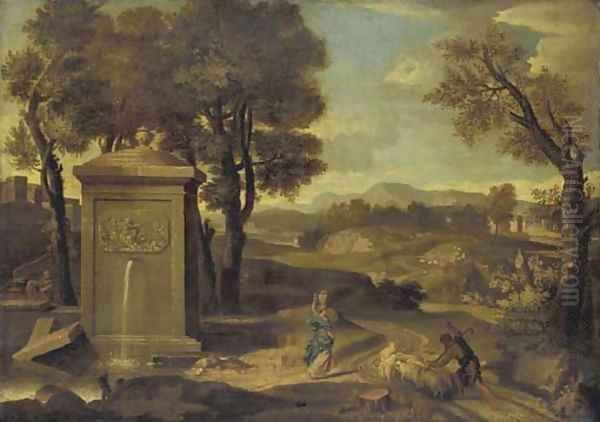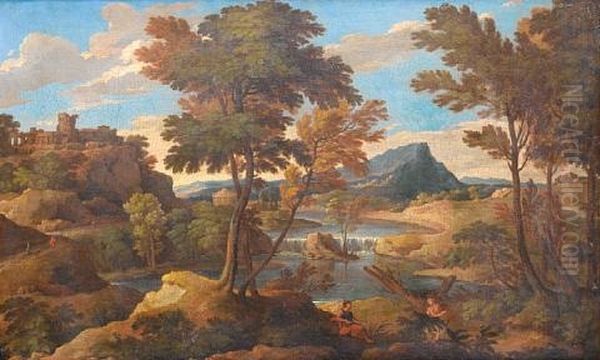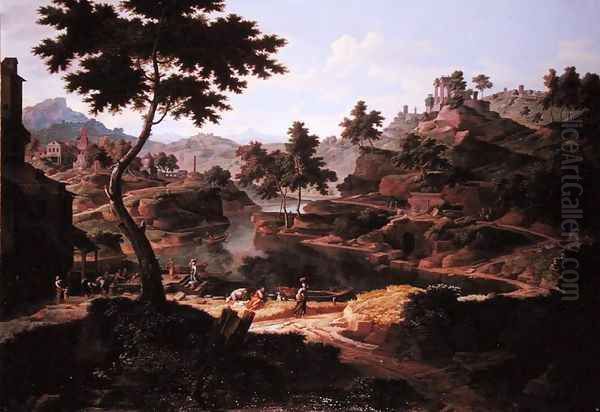Étienne Allegrain stands as a significant, if sometimes overlooked, figure in the rich tapestry of French Baroque art. A dedicated landscape painter, he carved a niche for himself during the opulent reign of Louis XIV, creating serene and idealized visions of nature that resonated with the classical sensibilities of his era. His work, deeply influenced by the titans of classical landscape, Nicolas Poussin and Claude Lorrain, contributed to a distinct French tradition of landscape painting that valued order, harmony, and a poetic interpretation of the natural world.
Early Life and Artistic Genesis in Paris
Born in Paris in 1644, Étienne Allegrain emerged from a family with artistic inclinations, a common phenomenon in an era where crafts and artistic skills were often passed down through generations. While specific details of his earliest training remain somewhat obscure, it is certain that he matured in a city that was rapidly becoming the artistic capital of Europe under the ambitious cultural policies of Louis XIV. The artistic environment of Paris at this time was vibrant, dominated by the powerful Académie Royale de Peinture et de Sculpture, which set the standards for taste and artistic production.
Allegrain's formative years would have exposed him to the prevailing artistic currents, particularly the ascendancy of classicism. This movement, which looked back to the art of antiquity and the High Renaissance, emphasized reason, order, and idealized beauty. For a landscape painter, this meant moving beyond mere topographical representation to create compositions that were intellectually structured and emotionally evocative, often imbued with a sense of timelessness. His family background likely provided initial encouragement and perhaps rudimentary instruction, paving the way for a more formal engagement with the artistic practices of his time.
The Enduring Influence of Poussin and Lorrain
The most profound influences on Étienne Allegrain's artistic development were undoubtedly Nicolas Poussin (1594–1665) and Claude Lorrain (1600–1682). Though both were French, they spent most of their careers in Rome, and their works, which were highly sought after by collectors across Europe, including in France, established the canon for classical landscape painting.

Nicolas Poussin was revered for his intellectually rigorous compositions, often featuring biblical or mythological scenes set within meticulously constructed landscapes. His landscapes were not wild or untamed but rather ordered environments, where nature was harmonized with human action and narrative. Poussin’s emphasis on clarity, balance, and a rational arrangement of forms provided a powerful model for subsequent generations. Allegrain would have absorbed Poussin’s approach to structuring space and integrating figures (though often minor in Allegrain's own work) within a coherent and idealized natural setting.
Claude Lorrain, on the other hand, was celebrated for his mastery of light and atmosphere. His idealized landscapes, often depicting pastoral scenes or seaport views at dawn or dusk, are suffused with a soft, golden light that creates a poetic and nostalgic mood. Claude’s ability to capture the subtle gradations of light and air, and his skill in leading the viewer’s eye through expansive, receding vistas, were revolutionary. Allegrain clearly studied Claude’s techniques for rendering atmospheric perspective and creating a sense of depth and luminosity. The serene, often tranquil quality of Allegrain's landscapes owes much to Claude's example. Another significant figure in this tradition, and a contemporary of Poussin and Claude, was Gaspard Dughet (1615-1675), Poussin's brother-in-law, whose landscapes, often more rugged and romantic, also contributed to the vocabulary of classical landscape available to artists like Allegrain.
Academic Recognition and Royal Patronage
A pivotal moment in Étienne Allegrain's career came in 1677 when he was received as a member of the prestigious Académie Royale de Peinture et de Sculpture. Membership in the Académie, founded under the patronage of Cardinal Mazarin and later championed by Jean-Baptiste Colbert, Louis XIV's finance minister, and dominated by the artistic direction of Charles Le Brun (1619-1690), was a mark of significant professional achievement. It granted artists official recognition, access to royal commissions, and the opportunity to exhibit their work. For Allegrain, this acceptance signified his establishment within the French artistic elite.
His talents did not go unnoticed by the court. During the reign of Louis XIV, the arts were systematically employed to glorify the monarch and the French state. The grand building projects, most notably the Palace of Versailles and its associated structures, required vast numbers of artworks, from monumental history paintings and portraits by artists like Hyacinthe Rigaud (1659-1743) and Nicolas de Largillière (1656-1746) to decorative schemes and, importantly, landscapes.

Allegrain received commissions to contribute to these royal enterprises. He was tasked with creating decorative landscapes for the Grand Trianon at Versailles, a more intimate retreat for the King, with documented commissions in 1688 and 1695. These works would have been designed to complement the architecture of Jules Hardouin-Mansart (1646-1708) and the formal gardens designed by André Le Nôtre (1613-1700). Around 1700, he also painted a series of four landscapes for the Ménagerie (the royal zoo) at Versailles. These commissions demonstrate the esteem in which his work was held and his integration into the vast artistic machine that served the Sun King.
Artistic Style: Serenity and Idealized Nature
Étienne Allegrain’s style is characterized by its adherence to the principles of classical landscape. His paintings typically depict idealized, tranquil scenes, often featuring calm bodies of water, gently rolling hills, picturesque trees, and distant, hazy mountains. Architectural elements, such as classical ruins, villas, or bridges, are frequently incorporated, adding a sense of history and human presence, though the figures themselves are usually small and serve primarily to animate the scene or provide scale.
His compositions are carefully balanced and ordered, with a clear recession of space created through atmospheric perspective and the careful arrangement of landscape elements in distinct planes – a foreground, middle ground, and background. The light in his paintings is generally soft and diffused, contributing to the overall mood of serenity and timelessness. While he may not have achieved the sublime luminosity of Claude Lorrain or the intellectual depth of Poussin, Allegrain skillfully synthesized their influences into a personal style that was elegant, refined, and perfectly suited to the decorative needs of his patrons.
His palette tends towards cool blues and greens for the foliage and distant vistas, often warmed by earthy tones in the foreground. The brushwork is typically smooth and controlled, emphasizing the clarity of form and the overall harmony of the composition rather than expressive texture. This contrasts with the more dramatic and turbulent landscapes of some Italian Baroque artists like Salvator Rosa (1615-1673), whose work represented a different, more romantic sensibility. Allegrain’s landscapes are, above all, places of peaceful contemplation.
Representative Works: "Landscape by a Lake"
Among Étienne Allegrain's known works, "Landscape by a Lake" (Paysage au bord d'un lac), painted around 1700, is often cited as a representative example of his style. This painting, now in the collection of the Louvre Museum in Paris, showcases many of his characteristic features. It presents an expansive, serene view across a calm lake towards distant, blue-tinged mountains. The foreground is anchored by carefully rendered trees with delicate foliage, and a sense of depth is masterfully achieved through layers of receding landscape.

The composition is balanced, with the eye gently led from the darker foreground elements towards the lighter, more ethereal background. Small figures can be seen, perhaps engaged in leisurely pursuits, but they are subordinate to the grandeur and tranquility of the natural setting. The overall atmosphere is one of peacefulness and idealized beauty, reflecting the classical aesthetic that Allegrain championed. Other works, including those created for the Trianon and the Ménagerie, would have shared these qualities, tailored to fit specific decorative contexts within the royal palaces. The Metropolitan Museum of Art in New York also holds works by Allegrain, attesting to his enduring, if quiet, appeal.
The Allegrain Artistic Dynasty
Étienne Allegrain was not the sole artist in his family; he was part of what could be considered an artistic dynasty. His son, Gabriel Allegrain (c. 1679–1748), also became a painter, following in his father's footsteps as a landscapist. Gabriel inherited Étienne's classical style but is often noted for employing a warmer palette and a somewhat freer, more painterly touch in his works. This subtle evolution shows how artistic traditions could be transmitted and adapted within a family.
Another, and perhaps more famous, son of Étienne was Christophe-Gabriel Allegrain (1710–1795). Unlike his father and brother, Christophe-Gabriel became a renowned sculptor. He achieved considerable success, becoming a member of the Académie Royale and producing notable works such as his celebrated "Bather" (Vénus au bain), a graceful and sensuous marble sculpture that is a prime example of the Rococo style. The fact that Étienne's sons pursued different artistic paths—one continuing the landscape tradition, the other excelling in sculpture—highlights the diverse talents within the family. There is also mention of a brother, Jean-Baptiste Allegrain, who was reportedly also a landscape painter, further underscoring the artistic environment in which Étienne lived and worked.
Contemporaries and the Broader Artistic Context
Étienne Allegrain worked during a period of great artistic activity in France. While Poussin and Claude were the dominant influences on classical landscape, other French artists were also active in this genre. Francisque Millet I (born Jean-François Millet, 1642–1679), an older contemporary, was known for his Poussinesque landscapes. Henri Mauperché (c. 1602–1686) was another established landscape painter. Pierre Patel the Elder (c. 1605-1676) and his son Pierre-Antoine Patel the Younger (1648-1707) also specialized in classical landscapes, often with an emphasis on ruins and architectural elements, creating a style sometimes compared to that of Claude Lorrain.
The court of Louis XIV also employed artists with different specializations. Adam Frans van der Meulen (1632–1690), originally from Brussels, became famous for his detailed battle scenes and topographical views documenting the King's military campaigns and royal residences. Jean Cotelle the Younger (1646–1708) was known for his decorative paintings, including mythological scenes and garden views, often for the Trianon, making him a direct contemporary working in similar locations to Allegrain. Sébastien Bourdon (1616-1671), a versatile artist, also produced notable landscapes in addition to his religious and mythological paintings.
It is also worth noting the case of François Perrier (1590-1650), an earlier French painter who also worked in an Italianate classical style. Though from a slightly earlier generation, his name sometimes appears in discussions of artists whose works might be confused with those of later classicists if not carefully attributed. Some sources suggest Perrier's style, in turn, had affinities with later Italian landscape painters like Andrea Locatelli (1695-1741), who worked in a more Rococo vein of idealized landscape. The Marquis de Chennevières, a 19th-century collector and art historian, famously owned a landscape he attributed to Allegrain, describing its style as reminiscent of "Poussin and Guaspe" (Gaspard Dughet), highlighting the perceived lineage.
Later Career, Death, and Legacy
Étienne Allegrain continued to paint into the early 18th century, dying in Paris in 1736 at the advanced age of 92. By the time of his death, artistic tastes in France were beginning to shift. The grandeur and formality of the Baroque style associated with Louis XIV were gradually giving way to the lighter, more intimate, and playful Rococo style, exemplified by artists like Jean-Antoine Watteau (1684–1721), François Boucher (1703–1770), and Jean-Honoré Fragonard (1732–1806).
While Allegrain's classical landscapes might have seemed somewhat conservative in the face of these new trends, his contribution lay in his steadfast adherence to and skillful interpretation of the classical tradition. He helped to sustain a taste for ordered, idealized landscapes that offered a vision of nature as a place of harmony and tranquility. His work provided a French-based continuation of the Poussin and Claude legacy, distinct from artists who might have more directly imitated Italian models.
His influence on subsequent generations of landscape painters was perhaps not as direct or transformative as that of Poussin or Claude. However, the classical landscape tradition itself remained a powerful undercurrent in French art, re-emerging with renewed vigor in the Neoclassical period later in the 18th century with artists such as Pierre-Henri de Valenciennes (1750-1819) and Jean-Victor Bertin (1767-1842), who, in turn, taught Jean-Baptiste-Camille Corot (1796-1875). While Allegrain may not be a direct link in this later chain, his career represents an important phase in the persistence of classicism in French landscape painting.
Rediscovery and Appreciation
For a period, Étienne Allegrain, like many competent but not superstar artists of his time, was somewhat overshadowed by bigger names or changing fashions. However, art historical scholarship in the 19th and 20th centuries led to a re-evaluation of many such figures. His works are now found in major museum collections, including the Louvre in Paris and the Metropolitan Museum of Art in New York, allowing contemporary audiences to appreciate his skill and the serene beauty of his art.
His paintings are valued for their technical accomplishment, their embodiment of French classical taste, and their role in the decorative programs of significant historical sites like Versailles. They offer a window into the aesthetic preferences of the late 17th and early 18th centuries in France, a period when art was closely allied with power and prestige.
Conclusion: An Elegant Interpreter of the Classical Ideal
Étienne Allegrain was a dedicated and skilled practitioner of classical landscape painting in France. Working within the long shadows cast by Poussin and Claude Lorrain, he developed a personal style characterized by elegance, harmony, and a profound sense of tranquility. His membership in the Académie Royale and his commissions for Louis XIV attest to his contemporary success and the esteem in which his art was held.
Though perhaps not an innovator on the scale of his primary influences, Allegrain played a crucial role in perpetuating and popularizing the classical landscape tradition in France. His idealized visions of nature, meticulously composed and imbued with a gentle, poetic light, provided an aesthetic counterpoint to the grandeur of the Baroque era. As a key figure in a distinguished artistic family, and as a contributor to the artistic splendor of Versailles, Étienne Allegrain remains an important artist for understanding the nuances of French art during one of its most brilliant periods. His legacy is one of quiet beauty and enduring classicism.